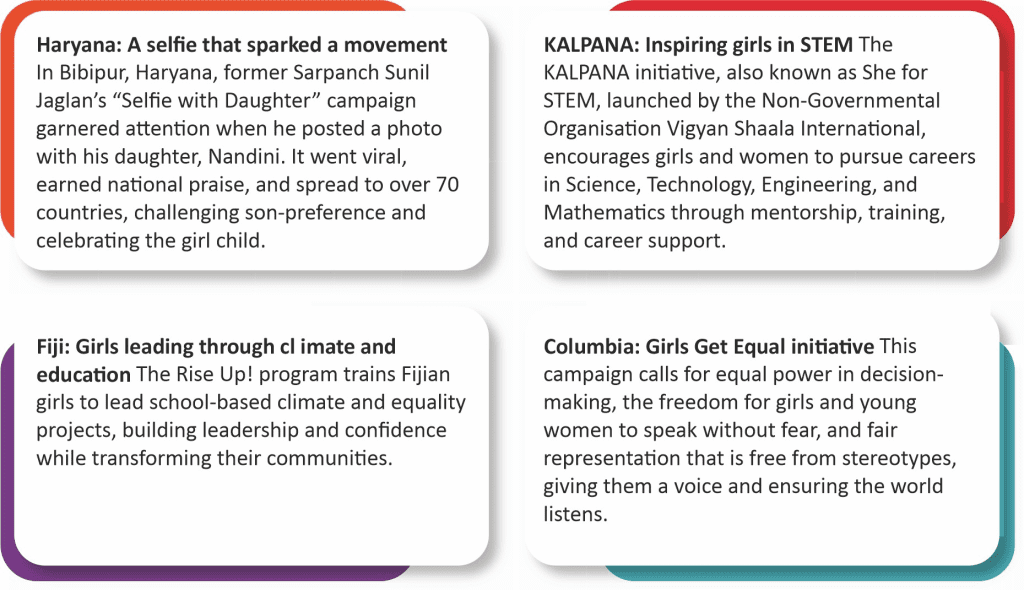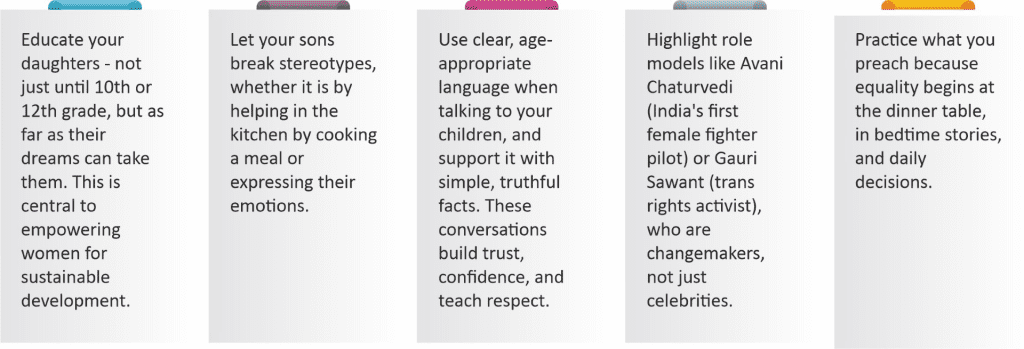![]()
Empowering women isn’t just a moral choice; it is a demographic necessity for a just and sustainable future.
| In this article, you’ll explore: ➡️ The girl who chose science over silence ➡️ Why gender equality is a demographic game-changer ➡️ Education: The first step towards autonomy ➡️ From the ground up, she builds better lives ➡️ Effects of gender inequality on population structure ➡️ From paper to practice: Global shifts, local reforms ➡️ Gender equality in developing countries: An unfinished agenda ➡️ Schools and family: Planting the seeds of equality |
The girl who chose science over silence
Priya’s father ran a small tea stall in a small town in Tamil Nadu. She helped before school, after school, and on weekends – but never once complained.
But deep down, she wanted to do something more than boil water and count coins. She had a dream of pursuing a career in science. When a local NGO offered her a scholarship, her family hesitated.
“Who will run the stall?” “What will science do for a girl?”
But Priya didn’t back down. She passed her Class XII examination with distinction, enrolled in public health, and came back – not with rebellion, but with resolve.
Today, she teaches younger girls about the power of education. She speaks at local schools, encouraging families to invest in their daughters’ education and helping girls believe in their own potential.
That’s the quiet revolution behind the education and empowerment of women.
………………………………………………………………………..……………………………
“When you educate a man, you educate an individual. When you educate a woman, you educate the whole family.” – African proverb
Why gender equality is a demographic game-changer
Some may think gender equality and population growth are two separate ideas. But they’re deeply connected. When girls have the same access to education, support, and opportunities as boys, communities become stronger and more resilient.
Sikkim, known for its high literacy and gender-inclusive policies, has a literacy rate of 81.42%, with female literacy standing at 75.61%.
Rwanda introduced gender equity laws and school enrolment reforms, resulting in 98% of girls enrolling in primary schools.
This is the connection between women’s empowerment and population growth rates – a quiet revolution evident in classrooms filled with curious minds and confident voices. Through education, women help uplift an entire community and reshape the demographic future.
Education: The first step towards autonomy
Education lays the foundation for newer possibilities. When a girl stays in school, her voice grows stronger, her confidence deeper, and her ability to lead – at home, in the classroom, and in the world – multiplies.
But when girls are denied education, the consequences extend far beyond the individual. In fact, as per the World Bank Group’s data, countries lose between $15 trillion and $30 trillion in potential earnings due to gender gaps in education.
This belief in the power of knowledge is what drove Srishti Bakshi to walk from Kanyakumari to Kashmir. Her CrossBow initiative spanned 260 days and covered 3,800 kilometres, highlighting the issues of women’s empowerment and safety.
Her mission was a bold stride for women’s rights and social change, powered by the belief that education and awareness are the strongest tools for empowerment.
From the ground up, she builds better lives
When women lead, education and awareness often follow. In India and around the world, women are showing that gender equality and learning go hand in hand.

Effects of gender inequality on population structure
When girls are not given equal access to education as well as opportunities, the imbalance begins early. In several districts across Northern India, deeply rooted social norms have discouraged girls from continuing their education beyond the primary level.
The Annual Status of Education Report 2023 mentions that the gender gap in enrolment is continuing to narrow. It also mentions that girls still lag in terms of access to or use of digital technologies.
Factors such as a lack of transportation, safety concerns, and traditional expectations often limit girls’ educational opportunities. Over time, gender inequality leads to visible shifts in the composition of classrooms, workplaces, and local governance. These everyday gaps in who learns and leads reveal the true effects of gender inequality on population structure.
From paper to practice: Global shifts, local reforms
While countries globally are championing women’s rights and social change, India isn’t too far behind. Closer to home, India’s gender mainstreaming in policy has taken root in various initiatives, such as Beti Bachao Beti Padhao, POSHAN Abhiyaan, and the National Education Policy 2020.
- Free mobility, real liberty:
Under Karnataka’s Shakti Scheme, over 500 crore free bus tickets have empowered 31 crore women in Mysuru alone, reclaiming not just mobility, but agency and independence.
- NEP and Navodaya: Rural Girls Rising
Aligned with NEP 2020, Jawahar Navodaya Vidyalayas now have around 42% girls enrolled, which provides them with a safe environment, nutritious meals, and high-quality education, enabling first-generation girls to excel.
- Mission Shakti: Women Leading Change
Since 2001, Mission Shakti in Odisha has brought together nearly 70 lakh women into 6 lakh SHGs. These women now run micro-enterprises, manage public services, and drive local development, turning policy into lasting empowerment.
These initiatives are empowering women to achieve sustainable population goals, especially in rural and marginalised communities.
Gender equality in developing countries: An unfinished agenda
While progress has been made, several girls, especially in rural areas, still face barriers to education. This is primarily due to the stigma imposed by society or limited support from family. True change begins with equal access to education, open conversations, and strong support at home, in schools, and within communities.
Schools and family: Planting the seeds of equality
Creating a gender-equal world begins in schools, in living rooms, and in everyday conversations.In schools:

At Home

A thriving population begins with equal opportunity. Educating girls, amplifying their voices, and shaping inclusive policies are key steps that lead to lasting progress. The link between gender equality and population growth is real and visible, in schools where girls stay longer and in village councils where women lead and make informed decisions. By empowering women, we not only strengthen the role of gender equality in development but also invest in a world where dignity, stability, and shared prosperity are possible for all.
